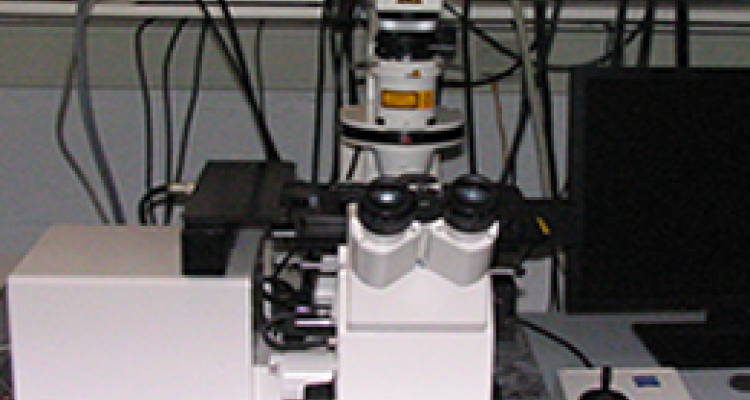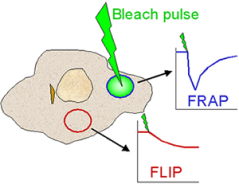
Equipment
Fluorescence Recovery After Photobleaching (FRAP)
FRAP is used to quantify diffusion of fluorescently labeled probes in cells.
Fluorescence Recovery After Photobleaching (FRAP) is a technique to monitor the diffusion of fluorescent particles. In comparison to FCS, FRAP requires higher amounts of dye (> 10-5M) and is not an equilibrium technique since a selected region will be photobleached by an intense laser pulse. Hereafter mobile molecules will enter the photobleached region from the surrounding area. The recovery of the fluorescence intensity contains information about the mobility of the molecules. A related technique is Fluorescence Loss In Photobleaching (FLIP): After the bleaching pulse fluorescence intensity is monitored in a region other than the photobleached region. Due to the altered concentration gradient between bleached area and surroundings a loss in intensity may be seen.

Equipment
FRAP is available on the Zeiss LSM510 confocal laser scanning microscope (CLSM). The instrument is based on an inverted microscope with a LSM-detector head coupled to the base port of the microscope. Excitation light is provided by an argon ion laser(458, 488 and 514 nm) and two helium neon lasers (543 and 633 nm).
All laser lines are combined and connected to the scanner head by means of a fiber optic. An Acousto Optical Tunable Filter (AOTF) allows to vary the intensity of laser light and enables to select excitation light of any combination. The LSM head contains a large set of excitation, dichroic and emission filters (flowchart), scanning mirrors, size adjustable pinholes and three sensitive photomultiplier tubes. Several water, oil and air immersible objectives (Zeiss) are present. This fully motorized system is PC-controlled and allows the real time monitoring of non-processed and ratio images.